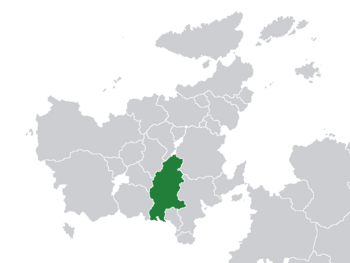User:Premislyd/Sandbox
South Euclean People's Republic [Amathian Translation] (Amathian) Republica Populará Sud-Eucléan (Barrois) República populara sud-euclèu (Liguersien) | |||||||||||||
|---|---|---|---|---|---|---|---|---|---|---|---|---|---|
| 1963–1982 | |||||||||||||
| Motto: Liberté, Egalité, Fraternité "Liberty, Equality, Freternity" | |||||||||||||
| Anthem: The Internationale | |||||||||||||
 Location of the South Euclean People's Republic (green) in Euclea (light grey) | |||||||||||||
| Capital | East Arciluco (until 1979) Brigançon (1979-1981) | ||||||||||||
| Official languages | None | ||||||||||||
| Recognised national languages | Amathian Barrois Liguersien | ||||||||||||
| Religion | State Atheism | ||||||||||||
| Demonym(s) | South Euclean(?) | ||||||||||||
| Government | Federal single-party republic under a totalitarian Equalist regime | ||||||||||||
| General Secretary | |||||||||||||
• 1963-1976 | Bastitou Couderç | ||||||||||||
• 1976-1989 | [Amathian Name] | ||||||||||||
• 1979-1980 | Carles Presseguer | ||||||||||||
• 1980-1982 | Jeremèis Dior | ||||||||||||
| President | |||||||||||||
• 1963-1969 (first) | [Amathian Name] | ||||||||||||
• 1982 | Adrian Fiorents | ||||||||||||
| Premier | |||||||||||||
• 1963-1971 (first) | [Amathian Name] | ||||||||||||
• 1980-1982 (last) | Jeremèis Dior | ||||||||||||
| Legislature | All-Euclean Federal Congress | ||||||||||||
| Council of the Republics | |||||||||||||
| Council of Nationalities | |||||||||||||
| Historical era | Great Game | ||||||||||||
| 1963 | |||||||||||||
| 22 January, 1964 | |||||||||||||
• Death of Bastitou Courderç | 6 August, 1973 | ||||||||||||
| 1980 | |||||||||||||
• Secession of Amathia | 10 May, 1980 | ||||||||||||
• Disestablished | Dissolution 1982 | ||||||||||||
| Population | |||||||||||||
• 1963 | 33,019,000 | ||||||||||||
• 1979 | 31,187,000 | ||||||||||||
• 1980 | 9,687,000 | ||||||||||||
• 1982 | 8,239,000 | ||||||||||||
| Currency | Libro (Ⰾ/₤) | ||||||||||||
| |||||||||||||
The South Euclean People's Republic, commonly referred to as the SEPR or simply Amathia-Champania, was a socialist federal republic located in central and southern Euclea that existed from its foundation in 1963 until its dissolution in 1982. The country bordered, from clockwise, East Miersa, Gaullica, Etruria, Piraea, Tengaria, Bistrava, and West Miersa.
Amathia-Champania traces its origins to the mid-to-late 1950s, where the Amathian and Champanois Sections of the Workers' International about the possibility of uniting the two countries into a single, socialist polity. Talks were halted briefly following the Equalist takeover in Amathia, but following a similar coup in Champania, talks resumed between the two governments. In 1961, the Amathian League of Equalist Unity and the League of Equalists of Champania came to an agreement, and following referenda in the Orangais Socialist Republic and Bregalian Socialist Republic, Champania was symbolically dissolved and the two constituent states entered a political union with Amathia.
Former Champanois Premier Bastitou Courderç was elected general secretary of the newly formed All-Euclean League of Equalists, and quickly developed a cult of personality. Under the Courderç government, Amathia-Champania became the "third-face" of global socialism alongside Kirenia and Dezevau, and established Equalism as a viable alternative to councilism abroad. Courderç continued the Equalist split from mainstream councilism that was initiated by the former Equalist government of Amathia, and battled Kirenia for influence abroad in the developing world.
Following the death of Couderç in 1976, the government and economy of the country began to collapse, leading to widespread inflation and unemployment. By 1980, poor socioeconomic conditions, exacerbated by the beginning of the 1980 economic crisis, prompted violent civil unrest to prop up throughout the country. The resulting Amathian Revolution led to the collapse of the governments in the Amathian states, causing the Amathian-Champanian government to relocate to the Orangais capital of Brigançon. Following the creation of the Amathian Democratic Republic, Amathia formally seceded from the South Euclean People's Republic, leaving a rump state that continued to exist in Champania. After existing for two years in Champania, the 19th session of the All-Euclean Federal Congress voted in favor to dissolve the South Euclean People's Republic. The League of Equalists of Champania subsequently formed the Champanois Socialist Republic.

